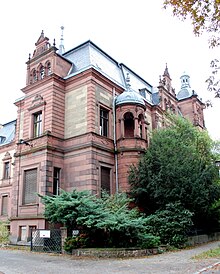Dippe brothers
The brothers Dippe AG was an important and traditional seed companies in Quedlinburg in today's Saxony-Anhalt .
history
The company was founded in Quedlinburg in 1850 by the brothers Gustav Adolf Dippe and Christof Lorenz Dippe . The company emerged from the small gardening business of the founder Johann Martin Dippe 's father, who had already passed away . The Dippe family owned garden land at the gates of Quedlinburg since 1714. Further cultivation areas were acquired in the vicinity of the city, for example in Word and in Bodegarten. Christof Lorenz Dippe left the company in 1863, but remained a partner. The most important product was sugar beet seeds . Thanks to new breeding and selection processes, the varieties achieved a high yield and a high sugar content. The company grew strongly. At the turn of the 19th and 20th centuries, the Dippe brothers covered a sixth of the world's demand for sugar beet seeds. The company also produced vegetable and flower seeds. In 1890 1,800 workers and 120 gardeners were employed. An area of 2500 hectares was cultivated. The company was considered to be the most versatile large-scale breeding company in the world.
The company's main courtyard was located at Neuer Weg 21 in Quedlinburg and is now a listed building . In the immediate vicinity of the company headquarters, villas of the Dippe family were built, which are also listed today. The Villa Neuer Weg 22, built in 1894/95, is located south of the factory entrance .
Carl Dippe and Friedrich Dippe , the sons of Gustav Adolf, and his son-in-law Carl Esche joined the company. Gustav Adolf Dippe died in San Remo in November 1890. A memorial created by Richard Anders , which is still preserved today, was placed on the company premises . After the death of his father, Carl Dippe ran the company. His successor, and the family had meanwhile been ennobled, was Friedrich von Dippe. In 1915 the company was converted into a public limited company. When the Bode flooded in 1925/26, the company premises were affected by flooding. In 1934 Hans von Dippe , Friedrich's son, took over the company. In the spring of 1945 2,500 people were working there. After the end of the Second World War , the company was expropriated. Hans von Dippe and Carl Esche junior founded the Gebrüder Dippe GmbH in Herford , which later relocated to Bad Salzuflen . In 1993 the company was taken over by the Swedish company Hilleshög .
The Quedlinburg plant was combined with the Mette plant in 1946 to form the German Seed Society . The Institute for Plant Breeding was founded on January 20, 1947 in the main courtyard of the Gebrüder Dippe AG. In 1971 the seed company became the VEB seed and plant material. From 1972 the institute was called the Institute for Breeding Research. After the political turning point in 1989 , the company was continued as Quedlinburger Saatgut GmbH. In 1998 the GmbH became a subsidiary of Julius Wagner GmbH Heidelberg . This company merged in 2002 to form Quedlinburger Saatgut GmbH. Under this name, the company continues the tradition of Gebrüder Dippe AG to this day.
Main courtyard Neuer Weg 21
The company premises at Neuer Weg 21 in Quedlinburg were continuously expanded between 1850 and 1910. Administration, production and residential buildings were built, with the development from the north, from the direction of the city of Quedlinburg, to the south. The older buildings were built in the classicism style , later in the historicist style. Storage and production buildings close off the area to the north, east and west. There are also six other historic buildings on the property. In the south-east there is a commercial building whose hall and interior design dates from 1960 and was in the form of the second modern. Also noteworthy is a water tower designed in the classicism style .
Directly behind the factory entrance is the monument created in 1906 for Gustav Adolf Dippe by the sculptor Richard Anders . It is designed in the style of historicism and shows a portrait bust of Dippes in addition to two bronze reliefs.
literature
- Falko Grubitzsch in: Georg Dehio : Handbook of German Art Monuments . Saxony-Anhalt. Volume 1: Ute Bednarz, Folkhard Cremer and others: Magdeburg administrative region. Revision. Deutscher Kunstverlag, Munich et al. 2002, ISBN 3-422-03069-7 , page 763.
- Falko Grubitzsch, Monument Directory Saxony-Anhalt, Volume 7.1, City of Quedlinburg , State Office for Monument Preservation and Archeology Saxony-Anhalt, Flyhead Verlag Halle 1998, ISBN 3-910147-67-4 , p. 193.
- Hans Kappert: Dippe, Gustav Adolf. In: New German Biography (NDB). Volume 3, Duncker & Humblot, Berlin 1957, ISBN 3-428-00184-2 , p. 736 f. ( Digitized version ).
Web links
- Information about Gustav Adolf Dippe at harzkaleidoskop.de
- Homepage of the Quedlinburger Saatgut GmbH
Individual evidence
- ^ Hans Kappert: Dippe, Gustav Adolf. In: New German Biography (NDB). Volume 3, Duncker & Humblot, Berlin 1957, ISBN 3-428-00184-2 , p. 736 f. ( Digitized version ).
- ↑ Personal-Notizen , Gustav Dippe, in: Hamburger Garten- und Blumenzeitung , vol. 46, 1890, p. 528, (short text, contains information on wills).
- ↑ Manfred Mittelstaedt, Quedlinburg , Sutton Verlag Erfurt 2003, ISBN 978-3-89702-560-8 , page 27
- ^ Rolf Bielau: Prisoners of War. Seed companies employ Poles and Ukrainians . Ed .: Mitteldeutsche Zeitung . Quedlinburg July 22, 2019 ( mz-web.de [accessed July 22, 2019]).
- ^ Manfred Mittelstaedt, Quedlinburg , Sutton Verlag Erfurt 2003, ISBN 978-3-89702-560-8 , page 92
- ^ Manfred Mittelstaedt, Quedlinburg , Sutton Verlag Erfurt 2003, ISBN 978-3-89702-560-8 , page 92
Coordinates: 51 ° 47 ′ 4.3 ″ N , 11 ° 8 ′ 34.5 ″ E


